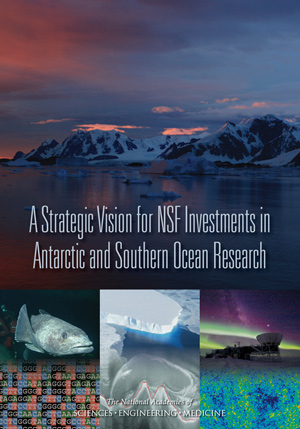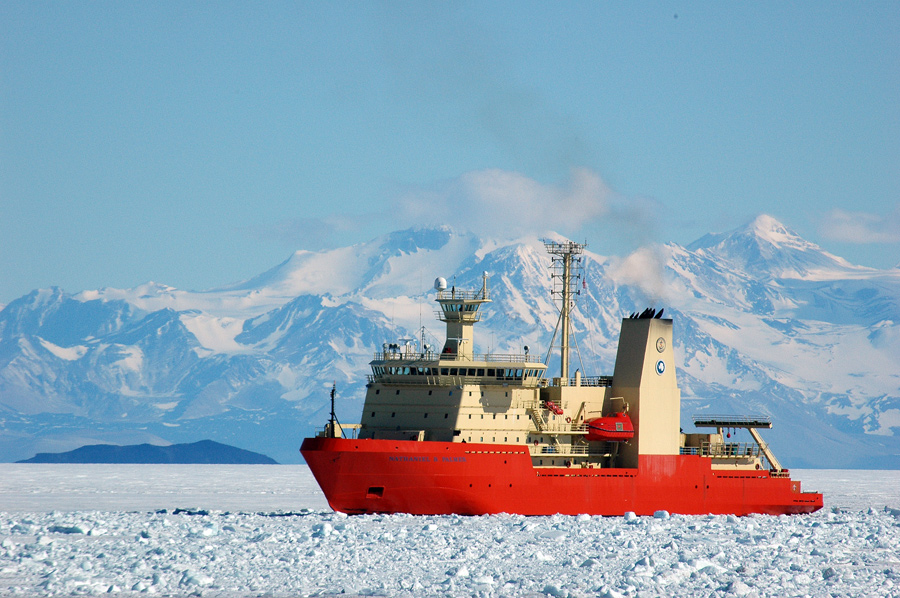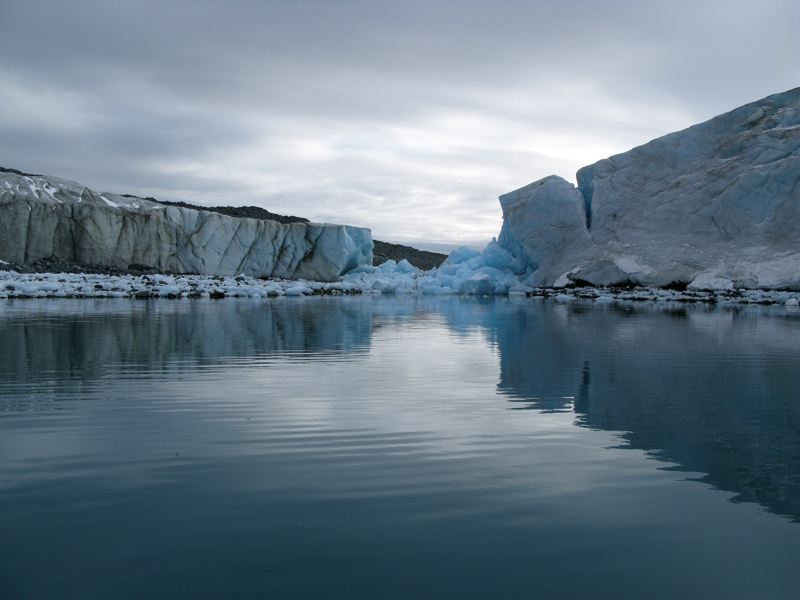Report Offers a Vision for the Next Decade of Antarctic ResearchPosted September 3, 2015
An expert panel convened by the National Academies of Science, Engineering, and Medicine recently released a strategic vision for the U.S. Antarctic Program (USAP) that lays out three “strategic priorities” for future research. The report, A Strategic Vision for NSF Investments in Antarctic and Southern Ocean Research 
Photo Credit: The National Academies
The report issued by the National Academies laid out a strategic plan for the next ten years of Antarctic research.
The strategic priorities include: efforts to understand the dimensions of potential sea level rise; studying how creatures adapt to the changing Antarctic environment; and the development of a next-generation Cosmic Microwave Background (CMB) research program at the South Pole in order to better understand both the eventual fate of the universe and how it evolved. Despite its focus on long-term strategic goals, the panel also stressed that the National Science Foundation (NSF) The report is advisory to NSF, which commissioned the study, and its suggestions offer one possible roadmap for the future direction of the program. Scott Borg, the head of NSF’s Antarctic Sciences Section, said that the agency is eager to see a wide distribution of the report’s recommendations in order to prompt a discussion in the research community and among other agencies with a stake in Antarctic research. Such an approach would help NSF shape it response to the recommendations. The authors recommended their three priorities based on the compelling science that could be done and the potential impact that research might have on society, as well as its time sensitivity, readiness and feasibility. First on the list of strategic priorities is a new initiative dubbed the “Changing Antarctic Ice Sheets Initiative,” to better understand how the loss of ice sheets in West Antarctica might affect the world’s temperate regions, which are home to billions of people. “The first priority, which is the largest of the three, is how fast and by how much will sea level rise,” said Robert Dunbar, an Earth sciences professor at Stanford University and a co-author, during a press conference announcing the release of the report. “There’s potentially vulnerable ice, an area of great concern, in Western Antarctica and this priority is aimed at better understanding the dynamics of current changes.” The report recommends that this multidisciplinary effort involve researchers in glaciology, Earth sciences, ocean science, atmospheric science and integrated systems science. The idea is to expand existing efforts to understand the past, present and future behavior of the marine ice sheets, in particular those in West Antarctica. “The changing ice initiative will require additional resources sustained over multiple years,” said Robin Bell, a geophysics professor at Columbia University and co-author of the report. She added that the committee decided to prioritize the initiative because of how big an impact rising oceans could have across the globe. “It’s really because of the urgency and magnitude of the threat that sea-level rise poses for human society.” On the biological frontier, Antarctica is home to some of the harshest environments on the planet and numerous species have adapted to thrive under these unforgiving conditions. Scientists have been studying the molecular biology, physiology and ecology of these adaptations for decades. However, recent technological advances can cheaply and easily decode the genomes and transcriptomes of organisms, opening up an unprecedented new avenue for investigating how these creatures survive. “The idea is to better understand how organisms have adapted, including their evolutionary history,” Dunbar said. “The point here is to take advantage of very recent and important advances… [and] to apply these very new techniques.” 
Photo Credit: Steven Lidstrom
BICEP3 and the South Pole Telescope may be joined by more instruments observing the cosmic microwave background.
Astronomers already take advantage of Antarctica’s dry, stable atmosphere as a platform to study of the CMB, the faint cosmic echoes from the Big Bang. The report calls for the USAP to join a next-generation experimental program called CMB Stage IV, which would require installation of a number of new detectors at the South Pole as part of a proposed global network of about 10 state-of-the-art telescopes. “The idea is to pursue a next-generation cosmic microwave background program,” Dunbar said. The telescopes would study the “fossil light” left over from the Big Bang, 13.8 billion years ago, which offers researchers them a peek at the universe shortly after its cataclysmic beginning. Telescopes at the South Pole, including the current South Pole Telescope as well as the BICEP and SPUD series of experiments, have been observing the CMB for years. The thin, dry air there and lack of light pollution are ideal for astronomical observations. But these new proposed detectors would offer a significant improvement in resolution. “It’s shovel ready, it’s compelling and it is quite relevant and important science to proceed with,” Dunbar said. “This is something that can help us understand physics at very high energy scales, much higher than we can simulate [in particle accelerators].” 
Photo Credit: Peter Rejcek
The research vessel Nathaniel B. Palmer navigates the ice in McMurdo Sound. The report recommended a new research vessel with more ice-breaking capabilities.
In addition to science recommendations, the report lays out a number of suggested goals for the USAP’s support operations. The biggest suggestion is that the USAP acquire a new, updated research vessel. The RVIB Nathaniel B. Palmer is nearing the end of its designed service life and has only limited ice-breaking capabilities. “The idea here is to get something that can expand on what the Palmer can do… Something that can get into thicker ice.” said John Carlstrom, an astrophysics professor at the University of Chicago and a co-author of the report. In addition, the report identifies a number of other possible ways NSF can further improve the resources it provides for Antarctic scientists, including greater access to remote field sites, more support for remote observation networks, a coordinated effort to share and store collected datasets and faster data transmission around the continent. “We all have lots and lots of data that we want to get back,” Carlstrom said. “We need to have very high bandwidth, big pipes coming back” to research institutions outside of Antarctica. The report’s authors drew on a number of recent external advisory documents that provided guidance to the USAP, including the National Research Council’s 2011 study Future Science Opportunities in Antarctica and the Southern Ocean The authors also interacted with the research community directly, receiving input from more than 450 people through in-person outreach sessions across the country and online forums. “The goal was to draw on widespread community engagement to develop a strategic vision for NSF’s investments in Antarctic and Southern Ocean research for the coming decade,” Bell said. |
"News about the USAP, the Ice, and the People"



For USAP Participants |
For The Public |
For Researchers and EducatorsContact UsNational Science FoundationOffice of Polar Programs Geosciences Directorate 2415 Eisenhower Avenue, Suite W7100 Alexandria, VA 22314 Sign up for the NSF Office of Polar Programs newsletter and events. Feedback Form |


